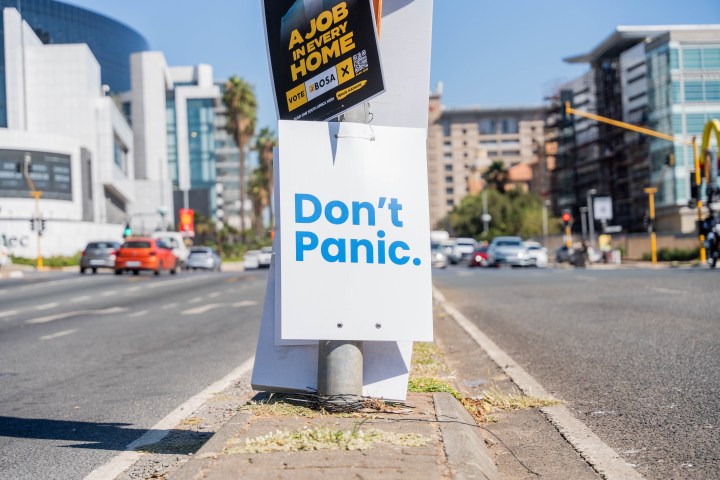POWER CRISIS
Presidency, big business double down on forecasted end to Eskom blackouts by 2025

Optimism regarding the end of Eskom blackouts is largely based on the explosion of renewable energy projects, especially solar, in recent months.
The Presidency and organised business remain committed to their forecast that higher stages of Eskom blackouts will end in 2024, but that if load shedding persisted during the year, the worst-case scenario was that it would be restricted to Stage 1.
Both parties also believe that blackouts will end entirely in 2025 after 16 years of damage to the economy and people’s quality of life.
Over the past year, some of the country’s top business leaders have partnered with government to mobilise skills and financial resources to help resolve the energy crisis, fix Transnet’s inability to operate efficiently and reduce crime and corruption.
Now, business leaders believe that reforms across key sectors of the economy are starting to deliver benefits, especially on the energy side.

Rudi Dicks (left), the head of the Project Management Office in the Private Office of the Presidency. (Photo: Ntswe Mokoena / GCIS) | Martin Kingston, Chairman of Business for South Africa (B4SA). (Photo: Supplied)
James Mackay, CEO of the Energy Council of South Africa and a member of the reform initiative between the Presidency and organised business, said the optimistic outlook on the end of Eskom blackouts is largely predicated on the explosion of renewable energy projects in the country, especially solar, in recent months.
In 2023, South Africa saw more than 2,600MW of roof-top solar installations, said Mackay, which made people’s homes and businesses partially independent of Eskom’s unreliable electricity supply.
More than a year ago, government allowed businesses to generate their own power and to sell excess electricity to the grid.
Since then, Mackay said businesses have been enthusiastic about developing wind and solar energy projects at a utility-scale — a growth trend he expects will continue in 2024 and 2025.
Mackay said the end-of-blackouts forecast by the Presidency and organised business is also informed by Eskom’s efforts to increase power plant performance and minimise breakdowns. This has, in part, helped South Africa to avoid load shedding over the past 40-odd days.
Read more in Daily Maverick: Fact Check — Has load shedding stopped because of the elections?
Read more in Daily Maverick: Twelve days of no load shedding — a glint, a sliver of hope that SA’s big problems can be solved
At a media briefing on 9 May, Mackay gave an update on energy reforms: “The plan [by Eskom to fix its power stations] said we can largely end load shedding in 2024, which, from an economic perspective, is an average Stage 1 and below.
“By the end of 2025, we would have recovered enough [electricity] in the system to have reserve margin and stability, where we can say we are out of load shedding.”
Rudi Dicks, head of the project management office in the Presidency, shared Mackay’s enthusiasm, saying there would be 22GW (22,000MW) of electricity generation capacity from the private sector in the coming years.
This generation capacity, said Dicks, is in the “final stages” and awaiting approval for grid access, a process of making the country’s electricity infrastructure available to connect the renewable energy produced by private players.
However, the infrastructure is old and inhibits grid access.
Read more in Daily Maverick: Private sector may have to foot R200bn for expanding SA’s electricity grid
“Our estimation is that during 2024, we will get under 4,000MW from private sector initiatives; in 2025, over 7,000MW; and 8,000MW in 2026. Irrespective of the situation, the private sector projects that were planned three years ago are now coming into fruition,” said Dicks.
Electricity procured from private producers through the previous six bidding rounds, as part of the IPP programme, is starting to deliver megawatts, he said.
The government recently launched bid window seven, which is set to procure 5,000MW of renewable energy capacity consisting of 3,200MW of onshore wind and 1,800MW of solar projects.
Bid submissions were scheduled for 30 April 2024 but there were delays, which might also push out the announcement of preferred bidders to a later date.
The optimism of the Presidency and organised business is not reflected in the Cabinet-approved draft 2023 Integrated Resource Plan (IRP), which serves as a guide for the procurement of new generation by the government.
The plan, which replaces the 2019 version, still sees power supply in South Africa being constrained for the next six years due to an “electricity supply gap”, despite efforts to add new supply to the grid.
Read more in Daily Maverick: Government’s Integrated Resource Plan acknowledges rolling blackouts will be with SA for years
Dicks said that the IRP is still being reviewed by government and will likely be amended to reflect the current energy reality.
On the logistics side, the Presidency and organised business want to help Transnet to move with speed in auctioning rail slots, allowing private sector players to use their skills to run trains/railway lines for a set period, while also investing in the upgrading and securing of infrastructure.
On crime and corruption, business wants to implement measures that help to speed up the successful prosecution of State Capture cases and capacitate the National Prosecuting Authority with private sector skills. It also hopes to see legislation passed to grant the Investigating Directorate permanency, with government recommendations on key intelligence, policing and security reforms to be implemented expeditiously.
Martin Kingston, the chair of Business for South Africa, said the upcoming general election would not delay the implementation of reforms as organised business was prepared to work with the next administration.
Most of the reform initiatives have a deadline of 2025, said Kingston. DM


















We’ll believe this article after 28 May.
How are our diesel utilisation volumes looking? Anyone know?
And to be honest very little contribution from the government except for minute taking and venue supply.
Doesn’t the (apartheid era) agreement to guarantee electricity from Cahora Bassa in Moz expire next year? Im not sure but I think that supplies about 16% of our current needs, That would be a VERY large spanner in the works as its supplied way below market rates to eskom
This may all be true, but we have been lied to so often that many people will not believe it.
If there is a reliable supply of electricity from Eskom the payback on installing solar panels and batteries is too long for many potential investors.
If the alternative is shutting down or burning diesel the economics change. If and when Eskom restores a reliable supply we can expect a decline in solar installations
Even if this true, which it is not, consider the medium term. Solar on rooftops increases, solar and wind for businesses and mines increase, solar and wind projects increase, taking up the gap which Eskom have been unable to fill. Say one third of SA’s electricity needs are then met by the abovementioned solar and wind initiatives, leaving two thirds of SA’s electricity needs supplied by Eskom, which they might just be able to cope with. And Eskom is left with the same organisation they have now, with billed revenue down by 33%. So then Eskom sells to the worst paying remaining consumers, and the municipalities sell to the worst paying consumers, all the best paying ones having been cherry picked out of the previous population of consumers. And collected revenue drops through the floor. And Eskom goes down the tubes after another R300bn of bailouts
ESKOM is a vehicle for the funneling of patronage to connected cadres. Thinking about it like its a business is foolish. The cadres will steal anything that’s able to be stolen so it will never be able to generate a surplus of anything much less electricity.